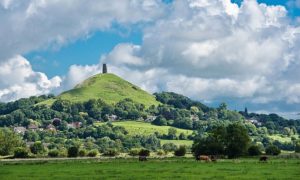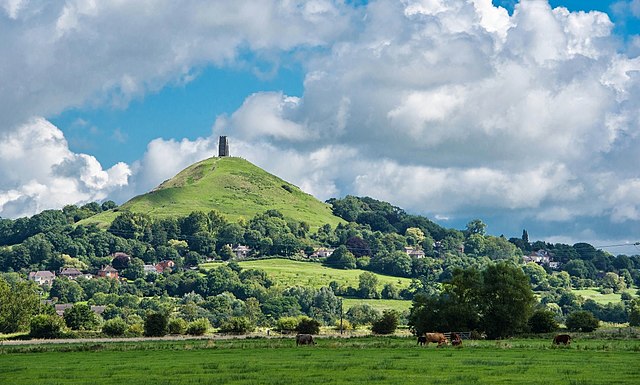by Carol Ohmart Behan
 The tradition of pilgrimage has been a time-honored practice in virtually all cultures beyond recorded history, its popularity undiminished to this day. Regardless of the goal,
The tradition of pilgrimage has been a time-honored practice in virtually all cultures beyond recorded history, its popularity undiminished to this day. Regardless of the goal,
a basic purpose of a pilgrimage is to make a special journey to a site that offers a unique connection with the sacred, the supernatural, the mysterious or the extraordinary in some way. The journey’s destination brings the pilgrim to a place “where the physical world meets the spiritual world.”
Religious pilgrimage is no doubt the most familiar kind and nearly all faiths encourage their followers in such journeys. For millennia Christians have aspired to visit the Holy Land of Jerusalem or places where Christian saints lived and performed their deeds. The annual Muslim pilgrimage, the Hajj, calls pilgrims to Mecca in Saudi Arabia to circle the Ka’Ba, the square, black-shrouded structure that houses the sacred Black Stone. The veneration of this sacred stone, thought now to be a meteorite, actually predates the formation of Islam. Hindus travel to the Ganges River in India seeking spiritual purification and believe life is incomplete without bathing at least once in its waters. In their eyes the river is a goddess, Ganga ma, (mother Ganga) who offers renewal and salvation.
Pilgrimage journeys are often undertaken for purposes of healing, be it of body, mind, or spirit. The destination may be humanmade such as the shrine of Sainte-Anne-de-Beaupre in a little Canadian town of the same name just outside of Quebec. The miraculous healings that have occurred there for several hundred years attract more than a million people every year. People stand in awe before ancient monuments such as Stonehenge in England, its towering, silent stones erected by our ancestors. It attracts over 800,000 visitors per year and several thousand gather on the summer solstice to watch the sunrise at this ancient and mystical site. Visitors from a variety of religious backgrounds have reported a strong sense of mystery and spiritual energy there.
On every continent Earth’s natural wonders also are points of pilgrimage offering their stunning beauties and grandeurs as balm for the spirit. A very few to mention are the Grand Canyon, the towering plume of Old Faithful’s geyser in Yellowstone National Park, and sacred mountains such as Mt. Fuji in Japan and Mt. Shasta in northern California. Ayers Rock in Australia, its native name, Uluru, like Mt. Shasta is considered a place of mystical power by native peoples and New Age practitioners alike. And circling all the continents is the Ocean herself, a source of inspiration and renewal for those of us who dwell inland.
On a smaller scale, a labyrinth is very much a place “where the physical world meets the spiritual world.” The labyrinth’s gently curved path leads the walker on a quiet, contemplative journey to its center. In my work with labyrinth I have witnessed people utilizing the labyrinth’s pathway for something that can well be described as an “inner pilgrimage”. So much of modern life urges us to focus on the outer world, but more and more people are seeking ways to explore “inner landscapes”. In my view, this yearning accounts in part for the resurgence of interest in the labyrinth, an ancient spiritual resource. I invite you to read my article on this at www.GoldenSpiralJourney.com
Other means to pursue a personal pilgrimage of our vast and unexplored inner world can be through meditation, journal or poetry writing, and seeking places of quiet and silence where “we can hear the soul speaking”.
Pilgrimage has always been and is still “work of the soul” from the planning, to the traveling, to reaching the journey’s destination. If you do not come from a religious or cultural tradition of pilgrimage, the call is sometimes more subtle. The poet Mary Oliver poses the question, “Tell me, what is it you plan to do / with your one wild and precious life?” There is an ever-increasing desire to live our lives from a deeper place, to spend more of our time “being” and less in “doing.” Oliver’s question beckons us to step outside the confines of our consumer focused, ego-driven culture. For those seeking this more conscious and spiritually-focused way of living, a pilgrimage journey offers abundant support in searching out this larger, more holistic life.
My own experience of pilgrimage came when I entered my fifth decade, wondering what I might do with “the rest of my life”. Some truly marvelous synchronicities (a good sign you’re on the right path) brought me to Glastonbury, England, and to its evocative and mystical energies. It has been a place of pilgrimage for a thousand years and more as early peoples came to drink and bathe in the healing waters of the two springs issuing from beneath the brooding hill or “Tor”. Of Glastonbury’s many myths, one is that the Holy Grail was brought here by Joseph of Arimatheia who is said to have founded the first Christian church in England. It grew into a fabulous and famous Abbey that drew devout pilgrims for hundreds of years. The legend of the Grail grew to encompass the mythical life of King Arthur and Guinevere, the energies of that story woven into all the rest. Down through the centuries, the Chalice Well at the “red spring”, sacred to the Divine Feminine, maintained its presence not far beyond the Abbey walls. In the summer of 2001, just another New Age pilgrim, I set foot on Glastonbury’s streets and climbed the Tor to find my own revelations.
The Chalice Well, set within its beautiful and peace-filled Garden, continues to draw people from all over the world in quest of the healing energies of its red-tinged waters, rising ever rising from its deep hidden source. During a visit there one summer afternoon, I saw a Spanish pilgrimage group clad in white outfits performing a healing ritual in the shallow bathing pool. Observing them, I was struck by how timeless this scene was and how all of us in the Garden that day were following in the footsteps of countless generations of pilgrims.
What one finds on a pilgrimage is often ineffable, and while I can only speak for myself, beyond a doubt my annual pilgrimages to Glastonbury continue to enlarge my life. I invite you to explore this ages-old pilgrimage destination by visiting my website. And since one article cannot possibly cover this tremendously large topic, I encourage you to explore further. Wonderful resources are just a mouse-click away on the World Wide Web. Enjoy your journey and Bright Blessings!
Carol Ohmart-Behan is a certified labyrinth-facilitator, pilgrimage leader, and published novelist. Details of her annual pilgrimages to Glastonbury and Southwest England (as well as information on her other work) can be found at www.GoldenSpiralJourney.com and www.MagdaleneGrailCircle.com
